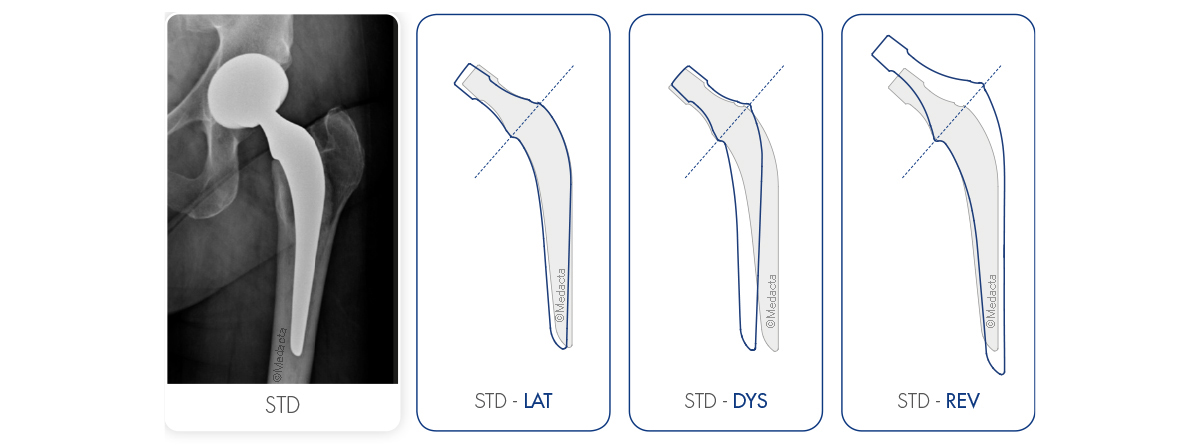
A renewed tradition
AMIS-K has been developed in collaboration with Dr. L. Kerboull and Professor M. Hamadouche, incorporating their own experience with the Charnley-Kerboull femur implant.[1] The AMIS-K stem is in line with the design of the Charnley-Kerboull implant, featuring a very thin cement mantle, and includes modifications aimed at simplifying its implantation using minimally invasive approaches.

AMIS-K is 12% shorter than Charnley-Kerboull type stems.[3] This reduction in length is intended to facilitate insertion of the femoral implant when using a minimally invasive procedure, such as the AMIS approach. An experimental study of the mechanical behavior of the AMIS-K stem has revealed that the shortened length does not affect the in vitro rotational and tilting stability after line-to-line cementation.[3]

A stem matching the femoral canal is implanted line-to-line, resulting in a thin cement mantle. The French technique is intended to maximize the stem size within the medullary canal, removing all cancellous bone and fitting the stem in place with cement as a filler only where the internal geometry of the bone does not match the implant shape. Excellent survival rates have been reported for THAs performed with the French technique, also referred to as the “French Paradox”.[1,2,4]

The AMIS-K stem is compatible with the “cement-in-cement” technique. In case of revision, the removal procedure is simpler when compared to a stem of regular length: distal cement removal is no longer mandatory, thereby reducing the complexity of the operating procedure.[5]

AMIS-K is available in 26 sizes including multiple options: Standard (STD), Lateralized (LAT), Dysplastic (DYS) and Revision (REV). The AMIS-K’s comprehensive product range allows for an efficient restoration of the joint biomechanics in a wide patient population.

MATERIAL:
SURFACE TREATMENT:
COLLAR:
SHAPE:
AMIS-K is available in 26 sizes, including multiple options:
11 STANDARD sizes with 130° neck - shaft angle
9 LATERALIZED sizes with 125° neck - shaft angle
4 DYSPLASTIC sizes with 130° neck - shaft angle
2 REVISION sizes with 130° neck - shaft angle



[1]Kerboull L, Hamadouche M, Courpied JP, et al. Long-term results of Charnley-Kerboull hip arthroplasty in patients younger than 50 years. Clin Orthop Relat Res 2004; 418:112-8
[2]Langlais F, Kerboull M, Sedel L, Ling R S M – Annotation – THE `FRENCH PARADOX’ The journal of bone and joint surgery – January 2003; Vol. 85-B, No. 1;20-17
[3]Hamadouche M, Ishaque B A, Kerboull L, Jakubowitz E - Length of clinically proven cemented hip stems: State of the art or subject to improvement? – International Orthopaedics · September 2014; 2.11 · DOI: 10.1007/s00264-014-2522-8
[4]Kutzner KP, Freitag T, Bieger R, et al. Biomechanics of a cemented short stem: standard vs. line-to-line cementation techniques. A biomechanical in-vitro study involving six osteoporotic pairs of human cadaver femurs. Clin Biomech (Bristol, Avon) 2018;52:86–94.
[5]Mounsey E J, Williams D H, Howell J R, Hubble M J – Revision of hemiarthroplasty to total hip arthroplasty using the cement-in-cement; The journal of bone and joint surgery – December 2015; Vol. 97-B, No. 12;1627-1623
[6]Thomsen M, Lee C - In-vitro Rotational Stability of Cemented Stem Designs - Part III - Modern Cementing Technique - Chapter 7.4; Springer/483/196-205
[7]Glyn-Jones S, Gill H S, Beard D J, McLardy-Smith P, Murray D W - INFLUENCE OF STEM GEOMETRY ON THE STABILITY OF POLISHED TAPERED CEMENTED FEMORAL STEMS - THE JOURNAL OF BONE AND JOINT SURGERY - Jan 2011; 44(1):22-7. doi: 10.1016
[8]AMIS Publication Review – M.O.R.E. Journal Supplement, April 2016. 99.98.publ rev.01.